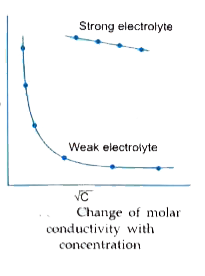Define molar conductivity of a substance and describe how for weak and strong electrolytes, molar conductivity changes with concentration of solute. How is such change explained ? A voltaic cell is set up at 25 °C with the following half-cells :
Ag+(0.001M)∣Ag and Cu2+(0.10M)∣Cu
What would be the voltage of this cell ? [E∘cell = 0.46 V]

(a) Molar conductivity may be defined as the conductance of all the ions at dilution V produced when one mole of the electrolyte is dissolved in V cm3 of the solution, the distance between the electrolytes being 1 cm.
Change of molar conductivity with concentration : Molar conductivity increases sharply for weak electrolytes with decrease in concentration as shown in the diagram because number of ions as well as mobility of ions increases with dilution.
In case of strong electrolytes, Λm increases slightly on dilution because number of ions do not increase much whereas mobility of ions increases.
(b) Cell reactions may be written as:
Cu(s)→Cu2+(aq)+2e−
2Ag+(aq)+2e−→2Ag(s)
--------------------------------------------
Cu(s)+2Ag+(aq)→Cu2+(aq)+2Ag(s)
Thus, n=2
Using Nernst equation and substituting the values, we have:
Ecell=E∘cel−0.5912log([Cu2+])[Ag+]2=0.46−0.05912log0.1(0.001)2
or Ecell=0.46−0.0295×5=0.3125 V
Topper's Solved these Questions
- ELECTROCHEMISTRY BOOK - U-LIKE SERIESCHAPTER - ELECTROCHEMISTRY EXERCISE - SELF ASSESSMENT TEST (SECTION A) MULTIPLE CHOICE QUESTIONS (CHOOSE THE CORRECT OPTION)
7 Videos
- ELECTROCHEMISTRY BOOK - U-LIKE SERIESCHAPTER - ELECTROCHEMISTRY EXERCISE - SELF ASSESSMENT TEST (SECTION B)
1 Videos
- ELECTROCHEMISTRY BOOK - U-LIKE SERIESCHAPTER - ELECTROCHEMISTRY EXERCISE - CASE BASED/SOURCE-BASED INTEGRATED QUESTIONS (LONG ANSWER QUESTIONS-I (3 MARKS EACH))
27 Videos
- COORDINATION COMPOUNDSBOOK - U-LIKE SERIESCHAPTER - COORDINATION COMPOUNDSEXERCISE - SELF ASSESSMENT TEST
7 Videos
- EXAMINATION PAPER 2020BOOK - U-LIKE SERIESCHAPTER - EXAMINATION PAPER 2020EXERCISE - SECTION D
15 Videos
Similar Questions
(a) Define molar conductivity of a substance and describe how for weak and strong electrolytes , molar conductivity changes with concentration of solute . How is such change explained ?
(b) A voltaic cell is set up at 25∘C with the following half cells :
Ag+(0.001M) | Ag and Cu2+(0.10M)∣Cu
What would be the voltage of this cell ? (E∘cell=0.46V)
View SolutionA voltaic cell is set up at 25∘C with the following half cells :
Ag+(0.001M) | Ag and Cu2+(0.10M)∣Cu
What would be the voltage of this cell ? (E∘cell=0.46V)
View SolutionA voltaic cell is set up at 25∘C with following half cells : Ag+(0.001M)∣Ag and Cu2+(0.10M)∣Cu What would be the voltage of this cell ? (E∘cell=0.45V)
View SolutionDefine molar conductivity of a solution and explain how molar conductivity changes with change in concentration of a solution for a weak and a strong electrolyte.
View Solution(i) State the relationship amongst cell constant of a cell, resistance of the solution in the cell and conductivity of the solution. How is molar conductivity of a solution related to conductivity of its solution ?
(ii) A voltaic cell is set up at 25 °C with the following half cell,
Al/Al3+(0.001M) and Ni/Ni2+(0.50M)
Calcualte the cell voltage: [E∘ni2+/Ni=−0.25V,E∘Al+/Al=−1.66V]
View Solution(a) State the relationship amongst cell constant of a cell , resistance of the solution in the cell and conductivity of the solution . How is molar conductivity of solute related to conductivity of its solution ?
(b) A voltanic cell is set up at 25∘C with the following half-cells :
Al∣Al3+(0.001M) and Ni∣Ni2+(0.50M)
Calculate the cell voltage [E∘Ni2+∣Ni=−0.25V,E∘Al3+∣Al=−1.66V]
View Solution(a) State the relationship amongst cell constant of a cell , resistance of the solution in the cell and conductivity of the solution . How is molar conductivity of solute related to conductivity of its solution ?
(b) A voltanic cell is set up at 25∘C with the following half-cells :
Al∣Al3+(0.001M) and Ni∣Ni2+(0.50M)
Calculate the cell voltage [E∘Ni2+∣Ni=−0.25V,E∘Al3+∣Al=−1.66V]
View SolutionCalcualte the emf of the following cell at 25∘ C
Ag(s)∣∣Ag+(10−3M)∣∣∣∣Cu2+(10−1M)∣∣Cu(s)
Given: E∘cell=+0.46V and log10n=n.
View Solution(a) Define molar conductivity of a solution and explain how molar conductivity changes with change in concentration of solution for a weak and a strong electrolyte.
(b) The resistance of a conductivity cell containing 0.001 M KCl solution at 298 K is 1500Ω. What is the cell constant if the conductivity of 0.001 M KCl solution at 298 K is 0.146×10−3Scm−1?
View Solution(a) Define molar conductivity of a solution and explain how molar conductivity changes with change in concentration of solution for a weak and a strong electrolyte.
(b) The resistance of conductivity cell containing 0.001MKCl solution at 298K is 1500ω.
What is the cell constant if the conductivity of 0.001MKCl solution at 298K is 0.146×10−3Scm−1
View Solution
